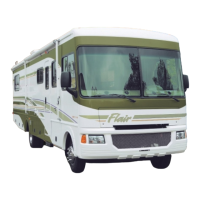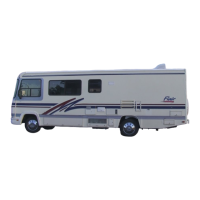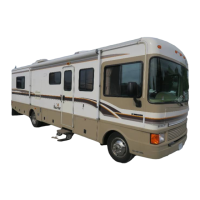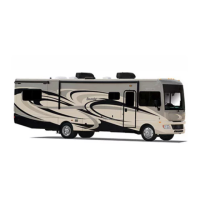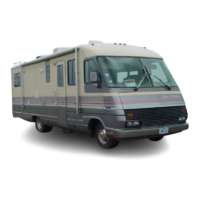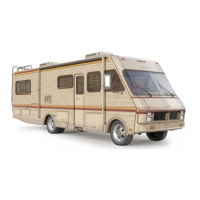Do you have a question about the Fleetwood Flair and is the answer not in the manual?
Details the warranty coverage for the motor home's systems and components.
Outlines the owner's responsibilities for maintenance and reporting issues.
Specifies the dealer's responsibilities for inspections and repairs.
Guidance on what to do if the dealer cannot resolve a warranty problem.
Details the manufacturer's responsibilities for resolving warranty issues.
Procedure if the manufacturing plant fails to resolve a warranty problem.
Lists exclusions from the warranty coverage, such as automotive systems and abuse.
Warnings about storing LP gas containers inside the vehicle due to pressure relief.
Advises against using cooking appliances for comfort heating due to asphyxiation risk.
Prohibits using portable fuel-burning equipment inside the vehicle due to fire/asphyxiation risk.
Prohibits storing flammable liquids inside the vehicle due to fire or explosion risk.
Steps to take if you smell gas, including extinguishing flames and shutting off supply.
Overview of the manual's purpose and content.
Details the contents of the owner's package for operation and maintenance.
Explains the meaning of 'WARNING', 'CAUTION', and 'NOTE' statements in the manual.
Clarifies the motor home is for recreational use, not permanent housing.
Switches radio power between chassis and coach batteries.
Component for audio playback.
12-volt accessory outlet.
Monitors generator operating hours.
Controls generator operation.
Controls for temperature and fan speed of HVAC system.
Refers to chassis operator's manual for instrument details.
Control for vehicle headlights.
Assists in starting engine with coach battery if chassis battery is dead.
Controls for remote mirrors and heating.
Guidelines for ensuring safe and proper loading of the motor home.
Considerations and guidelines for towing a load behind the motor home.
The owner's sole responsibility for safe and proper vehicle loading.
Explanation of terms like GVWR, GAWR, GCWR, GTW, and UVW.
Understanding how to distribute weight for optimal handling and safety.
Procedures for weighing the motor home with and without a trailer.
Advice on how to properly load items for better handling and safety.
Guidance on maintaining proper tire pressure for safety and tire life.
Requirements for selecting replacement tires that match original equipment.
Steps to take in case of sudden tire failure, including safe stopping procedures.
Advice on changing a flat tire, including when to seek professional help.
Explanation of how combination belts work and how to fasten them.
Procedures for periodic inspection and maintenance of safety belts.
Legal requirements and guidelines for using child safety seats and restraints.
Ensuring children use safety belts properly for maximum protection.
Using safety seats appropriate for the child's size and weight.
Instructions for safely opening the fuel filler cap to prevent fuel spray.
Explanation of fuel types and the phenomenon of vapor lock in gasoline engines.
Discussion of engine fan, exhaust system heat, and temperature gauges.
How the engine fan adjusts speed for cooling and potential noise.
Information on engine heat and the function of heat shields.
Information on the CO detector, its function, testing, and maintenance.
Instructions for extending and retracting manual entry steps.
How to operate power entry steps using ignition and step switches.
Information on separating and securing entry doors and screens.
Details on operating slider and torque pane windows, including drainage.
Instructions for using the emergency exit window for escape.
How to open, close, and lock side slider windows.
Information on adjusting sun visors for glare relief.
Instructions for raising, lowering, and adjusting mini-blinds.
Guidelines for using exterior and interior storage compartments safely.
Maintenance advice for interior materials like fabrics, upholstery, and finishes.
Steps to convert the dinette seating into a bed.
Instructions for converting the sofa into a bed and restoring it.
Information on maximizing space and securing items in exterior compartments.
How to open and use interior closets, cabinets, and drawers.
Operation and securing of interior room dividers and privacy curtains.
Information on types of interior lighting and their operation.
How to operate and maintain overhead vents for ventilation.
Checking tank levels and battery charge using the monitor panel.
Potential issues and considerations when occupying the motor home long-term.
Methods to reduce interior condensation during cold weather.
Using storm windows to reduce condensation.
Tips to minimize moisture release from activities like cooking and bathing.
Opening doors to improve air circulation and reduce condensation.
How a dehumidifier can help manage excess interior moisture.
Precautions for refueling, occupant instructions, and fire extinguisher maintenance.
Details on the smoke detector's function, testing, and battery replacement.
Information on using city water hookups and the on-board storage tank.
Steps for connecting to a city water supply and flushing the lines.
Procedure for filling the fresh water tank and advice on water storage.
How the 12-volt DC water pump works and its power requirements.
Instructions for inspecting, cleaning, and maintaining the in-line water filter.
Common water system problems and their causes, including leaks and neglect.
Identifying and fixing leaks in pipe fittings and connections.
Procedure for sanitizing the water tank and pipes using a bleach solution.
Using the exterior shower fixture.
Description of grey and black water tanks, drain plumbing, and sewer hose use.
Refers to the owner's manual for marine-type toilet operating instructions.
Procedure for draining black and grey water tanks, including safety warnings.
Tips for preventing clogs, proper tissue use, and approved cleaners.
Details the vehicle's electrical system, including battery, ignition, and lights.
Components powered by the 12-volt system, including lighting, outlets, and pump.
Information on replacing chassis bulbs and locating chassis fuses.
How to use the battery disconnect to prevent discharge during storage.
Safety warnings and procedures for inspecting and caring for batteries.
Guidelines for charging batteries from the chassis system or converter.
Advice on choosing a replacement battery with correct specifications.
Information on the solar panel's function for trickle-charging batteries.
Details on the 120-volt system, power cord, and safety precautions.
How the converter supplies 12-volt power and charges the coach battery.
Protection against electrical shock for certain outlets.
Procedure for testing and resetting the Ground Fault Interrupter.
Information on coach electrical protection devices and overload issues.
Details on the generator's function, power supply, and starting procedures.
How the generator draws fuel from the main tank or its own tank.
Critical safety warnings for generator operation, including exhaust and placement.
Note that wiring diagrams are not included, but troubleshooting info may be available.
Crucial safety guidelines for handling and using LP gas.
Procedure to follow if a gas leak is detected, including immediate actions.
Importance of inspecting the LP gas system for leaks before each trip.
Approved methods for checking LP gas leaks without using open flames.
Warning about potential damage to gas supply lines when drilling or fastening.
Ensuring easy access to LP tanks and their service valves.
Regulations on carrying or storing LP gas containers, including accessories.
Overview of system components like hoses and regulators.
Factors affecting LP gas system performance in cold weather.
Information on hose requirements, lifespan, and inspection for deterioration.
Explanation of the regulator's role in reducing tank pressure and vent importance.
Procedure for filling the chassis-mounted storage tank and safety warnings.
Methods for checking LP gas system for leaks, including using soap solution.
Information on the installed LP gas leak detector, its alarm, and testing.
Instructions for lighting LP gas appliances, including purging air and pilot lights.
How the LP gas water heater operates and its safety features.
Instructions for operating the refrigerator, including leveling and cooling tips.
Details on furnace operation, thermostat settings, and airflow requirements.
Basic operation of the LP gas range and the importance of ventilation.
Operation of the exhaust hood fan and light, and cleaning the grease filter.
How to operate the roof-mounted air conditioner and performance tips.
Selecting air conditioners based on the power source and switch operation.
Advice on powering 12-volt entertainment equipment.
Operation of optional front television and VCR, requiring 120-volt power.
Operating the optional rear TV on 12-volt or 120-volt power.
Information on the roof-mounted antenna, including lowering it for travel.
Troubleshooting common TV and radio signal interference issues.
Information on additional appliances operating on 120-volt power.
Guidelines for washing, waxing, and maintaining the exterior finish.
Procedures for adjusting, maintaining, and lubricating moving parts.
Cleaning and general care for the rubber roof material.
Methods for removing water-soluble and non-water-soluble stains.
Inspecting and resealing joints, windows, doors, and roof components.
How to identify and reseal areas with defective sealant around windows, doors, and roof.
Care instructions for interior furnishings like fabrics, laminate, and walls.
Guidelines for cleaning and maintaining interior fabrics and upholstery.
Cleaning instructions for laminate surfaces.
How to clean the oil-finished cutting block.
Cleaning methods for interior paneling and ceiling surfaces.
Recommended cleaners for bathtubs and plastic shower stalls.
Maintenance for vinyl flooring and carpeting.
Information on accessing the engine and properly installing the engine cover.
Reference to a comprehensive maintenance checklist included in the manual.
Steps for preparing the motor home for storage periods under 60 days.
Steps for preparing the motor home for storage periods over 60 days.
Steps to prepare the motor home for winter to prevent equipment failure.
Detailed steps for winterizing the fresh and waste water systems.
Procedure for bringing the motor home back into service after a storage period.
Details the warranty coverage for the motor home's systems and components.
Outlines the owner's responsibilities for maintenance and reporting issues.
Specifies the dealer's responsibilities for inspections and repairs.
Guidance on what to do if the dealer cannot resolve a warranty problem.
Details the manufacturer's responsibilities for resolving warranty issues.
Procedure if the manufacturing plant fails to resolve a warranty problem.
Lists exclusions from the warranty coverage, such as automotive systems and abuse.
Warnings about storing LP gas containers inside the vehicle due to pressure relief.
Advises against using cooking appliances for comfort heating due to asphyxiation risk.
Prohibits using portable fuel-burning equipment inside the vehicle due to fire/asphyxiation risk.
Prohibits storing flammable liquids inside the vehicle due to fire or explosion risk.
Steps to take if you smell gas, including extinguishing flames and shutting off supply.
Overview of the manual's purpose and content.
Details the contents of the owner's package for operation and maintenance.
Explains the meaning of 'WARNING', 'CAUTION', and 'NOTE' statements in the manual.
Clarifies the motor home is for recreational use, not permanent housing.
Switches radio power between chassis and coach batteries.
Component for audio playback.
12-volt accessory outlet.
Monitors generator operating hours.
Controls generator operation.
Controls for temperature and fan speed of HVAC system.
Refers to chassis operator's manual for instrument details.
Control for vehicle headlights.
Assists in starting engine with coach battery if chassis battery is dead.
Controls for remote mirrors and heating.
Guidelines for ensuring safe and proper loading of the motor home.
Considerations and guidelines for towing a load behind the motor home.
The owner's sole responsibility for safe and proper vehicle loading.
Explanation of terms like GVWR, GAWR, GCWR, GTW, and UVW.
Understanding how to distribute weight for optimal handling and safety.
Procedures for weighing the motor home with and without a trailer.
Advice on how to properly load items for better handling and safety.
Guidance on maintaining proper tire pressure for safety and tire life.
Requirements for selecting replacement tires that match original equipment.
Steps to take in case of sudden tire failure, including safe stopping procedures.
Advice on changing a flat tire, including when to seek professional help.
Explanation of how combination belts work and how to fasten them.
Procedures for periodic inspection and maintenance of safety belts.
Legal requirements and guidelines for using child safety seats and restraints.
Ensuring children use safety belts properly for maximum protection.
Using safety seats appropriate for the child's size and weight.
Instructions for safely opening the fuel filler cap to prevent fuel spray.
Explanation of fuel types and the phenomenon of vapor lock in gasoline engines.
Discussion of engine fan, exhaust system heat, and temperature gauges.
How the engine fan adjusts speed for cooling and potential noise.
Information on engine heat and the function of heat shields.
Information on the CO detector, its function, testing, and maintenance.
Instructions for extending and retracting manual entry steps.
How to operate power entry steps using ignition and step switches.
Information on separating and securing entry doors and screens.
Details on operating slider and torque pane windows, including drainage.
Instructions for using the emergency exit window for escape.
How to open, close, and lock side slider windows.
Information on adjusting sun visors for glare relief.
Instructions for raising, lowering, and adjusting mini-blinds.
Guidelines for using exterior and interior storage compartments safely.
Maintenance advice for interior materials like fabrics, upholstery, and finishes.
Steps to convert the dinette seating into a bed.
Instructions for converting the sofa into a bed and restoring it.
Information on maximizing space and securing items in exterior compartments.
How to open and use interior closets, cabinets, and drawers.
Operation and securing of interior room dividers and privacy curtains.
Information on types of interior lighting and their operation.
How to operate and maintain overhead vents for ventilation.
Checking tank levels and battery charge using the monitor panel.
Potential issues and considerations when occupying the motor home long-term.
Methods to reduce interior condensation during cold weather.
Using storm windows to reduce condensation.
Tips to minimize moisture release from activities like cooking and bathing.
Opening doors to improve air circulation and reduce condensation.
How a dehumidifier can help manage excess interior moisture.
Precautions for refueling, occupant instructions, and fire extinguisher maintenance.
Details on the smoke detector's function, testing, and battery replacement.
Information on using city water hookups and the on-board storage tank.
Steps for connecting to a city water supply and flushing the lines.
Procedure for filling the fresh water tank and advice on water storage.
How the 12-volt DC water pump works and its power requirements.
Instructions for inspecting, cleaning, and maintaining the in-line water filter.
Common water system problems and their causes, including leaks and neglect.
Identifying and fixing leaks in pipe fittings and connections.
Procedure for sanitizing the water tank and pipes using a bleach solution.
Using the exterior shower fixture.
Description of grey and black water tanks, drain plumbing, and sewer hose use.
Refers to the owner's manual for marine-type toilet operating instructions.
Procedure for draining black and grey water tanks, including safety warnings.
Tips for preventing clogs, proper tissue use, and approved cleaners.
Details the vehicle's electrical system, including battery, ignition, and lights.
Components powered by the 12-volt system, including lighting, outlets, and pump.
Information on replacing chassis bulbs and locating chassis fuses.
How to use the battery disconnect to prevent discharge during storage.
Safety warnings and procedures for inspecting and caring for batteries.
Guidelines for charging batteries from the chassis system or converter.
Advice on choosing a replacement battery with correct specifications.
Information on the solar panel's function for trickle-charging batteries.
Details on the 120-volt system, power cord, and safety precautions.
How the converter supplies 12-volt power and charges the coach battery.
Protection against electrical shock for certain outlets.
Procedure for testing and resetting the Ground Fault Interrupter.
Information on coach electrical protection devices and overload issues.
Details on the generator's function, power supply, and starting procedures.
How the generator draws fuel from the main tank or its own tank.
Critical safety warnings for generator operation, including exhaust and placement.
Note that wiring diagrams are not included, but troubleshooting info may be available.
Crucial safety guidelines for handling and using LP gas.
Procedure to follow if a gas leak is detected, including immediate actions.
Importance of inspecting the LP gas system for leaks before each trip.
Approved methods for checking LP gas leaks without using open flames.
Warning about potential damage to gas supply lines when drilling or fastening.
Ensuring easy access to LP tanks and their service valves.
Regulations on carrying or storing LP gas containers, including accessories.
Overview of system components like hoses and regulators.
Factors affecting LP gas system performance in cold weather.
Information on hose requirements, lifespan, and inspection for deterioration.
Explanation of the regulator's role in reducing tank pressure and vent importance.
Procedure for filling the chassis-mounted storage tank and safety warnings.
Methods for checking LP gas system for leaks, including using soap solution.
Information on the installed LP gas leak detector, its alarm, and testing.
Instructions for lighting LP gas appliances, including purging air and pilot lights.
How the LP gas water heater operates and its safety features.
Instructions for operating the refrigerator, including leveling and cooling tips.
Details on furnace operation, thermostat settings, and airflow requirements.
Basic operation of the LP gas range and the importance of ventilation.
Operation of the exhaust hood fan and light, and cleaning the grease filter.
How to operate the roof-mounted air conditioner and performance tips.
Selecting air conditioners based on the power source and switch operation.
Advice on powering 12-volt entertainment equipment.
Operation of optional front television and VCR, requiring 120-volt power.
Operating the optional rear TV on 12-volt or 120-volt power.
Information on the roof-mounted antenna, including lowering it for travel.
Troubleshooting common TV and radio signal interference issues.
Information on additional appliances operating on 120-volt power.
Guidelines for washing, waxing, and maintaining the exterior finish.
Procedures for adjusting, maintaining, and lubricating moving parts.
Cleaning and general care for the rubber roof material.
Methods for removing water-soluble and non-water-soluble stains.
Inspecting and resealing joints, windows, doors, and roof components.
How to identify and reseal areas with defective sealant around windows, doors, and roof.
Care instructions for interior furnishings like fabrics, laminate, and walls.
Guidelines for cleaning and maintaining interior fabrics and upholstery.
Cleaning instructions for laminate surfaces.
How to clean the oil-finished cutting block.
Cleaning methods for interior paneling and ceiling surfaces.
Recommended cleaners for bathtubs and plastic shower stalls.
Maintenance for vinyl flooring and carpeting.
Information on accessing the engine and properly installing the engine cover.
Reference to a comprehensive maintenance checklist included in the manual.
Steps for preparing the motor home for storage periods under 60 days.
Steps for preparing the motor home for storage periods over 60 days.
Steps to prepare the motor home for winter to prevent equipment failure.
Detailed steps for winterizing the fresh and waste water systems.
Procedure for bringing the motor home back into service after a storage period.
| Brand | Fleetwood |
|---|---|
| Model | Flair |
| Category | Motorhomes |
| Language | English |



